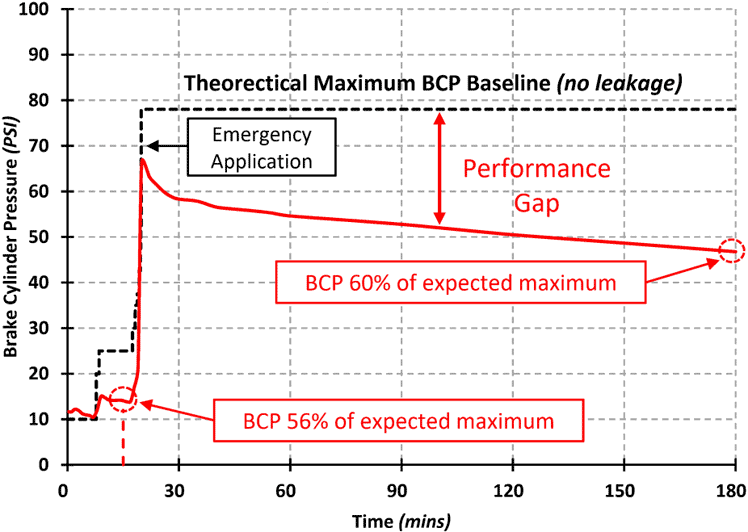
pressure for all 13 cars - Temperature -19C to -21C - TSB ☀1.

Kicking Horse River British Columbia - Hours before a Canadian Pacific (CP) train derailed in the rugged mountains of British Columbia,
killing three railroaders, the previous crew had struggled to keep the doomed grain train under control on a steep grade.
On Thursday, investigators with the Transportation Safety Board of Canada (TSB)
provided new
details about their inquiry into the fatal 4 Feb 2019 derailment on Kicking Horse Pass near Field, B.C., and offered suggestions to regulators on how
to prevent future tragedies.
According to TSB investigators, the previous crew aboard CP train 301-349 made an emergency brake application near Partridge, the last station before the train
entered the Upper Spiral Tunnel, because the train was exceeding the posted speed limit of 15 miles per hour.
The crew tried to use normal brake procedures to slow the train down but was unsuccessful.
According to investigators, the train was traveling at 23 miles per hour when the engineer decided to make an emergency application.
According to CP operating rules, any time a train is going 5 miles per hour over the speed limit on a descending grade it is considered an "uncontrolled
movement and must be stopped immediately by whatever means available," including an emergency brake application.
After stopping, the train sat on the 2.2 percent grade with the air brakes applied for nearly three hours.
During that time, the air brakes slowly lost their grip on the parked train.
Two hours and 45 minutes after the train was stopped at Partridge, a relief crew came on duty.
The new crew was on the train for about 10 minutes when it began to roll downhill.
After exiting the Upper Spiral Tunnel, the train derailed and the lead locomotive ended up in the Kicking Horse River.
Conductor Dylan Paradis, engineer Andrew Dockrell, and trainee Daniel Waldenberger-Bulmer were all killed.
After the derailment, investigators took the 12 grain cars that did not derail and conducted extensive tests to the air brake systems, with weather conditions
similar to the night of the derailment.
The tests revealed that the car's air brake system failed to maintain constant pressure over time.
"The air brake system on these cars would not provide adequate braking effectiveness to ensure the safe operation of a loaded unit grain train in a
situation where the air brakes are required to remain applied for an extended duration, such as while descending a steep grade," TSB officials
write.
TSB officials have urged government regulators to review its rules regarding air brake maintenance and inspections, especially for railroads operating in
mountainous territory.
"A properly functioning air brake system is of the utmost importance in mountain territory from a safety standpoint," officials write.
The TSB has not indicated when it hopes to complete its investigation.
Kicking Horse Pass, home CP's iconic Spiral Tunnels and known to local railroaders as "The Big Hill," has been the site of numerous derailments and
runaways in the past century.
In fact, just a month before the fatal derailment near February, a train derailed inside the Upper Spiral Tunnel.
OKthePK Joint Bar Editor: There has been some confusion in news reports as to whether it was the Upper or Lower Spiral Tunnel.
Justin Franz.
As I understand it, one of the issues that has come up in the investigation is the elimination of the COTS requirement which required a car's brake system
to cleaned, oiled, and tested on a periodic basis. A number of years ago the AAR successfully argued before the FRA that these tests were a waste of time and
money. As seen below the rules were relaxed effective January 1992. What I am hearing is that these relaxed rules may now have come back to haunt the railway.
The CP train was made up of mostly of older cars that may have been able to pass a brake test requiring them to set up and release on command but they appear
to have been unable to hold the brakes applied for any extended length of time.
COTS (Clean, Oil, Test, and Stencil) is rule 2 of the 1980 AAR Interchange Rules and applies to the air brake equipment on freight
cars.
"NEW" repair track test and single car test, which have been used industry-wide since January of 1992, are a much better and more
comprehensive method of detecting and eliminating defective brake equipment and components than the old, time-based COTS requirements.
This is the issue that is being referred to in the 4th paragraph from the bottom.
DW
provisions in Section 29 of the Canadian
Copyright Modernization Act.

